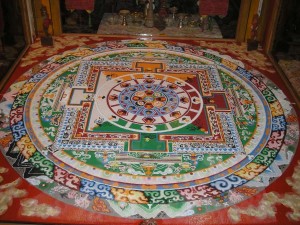༄༅།། དཔལ་འཁོར་ལོ་བདེ་མཆོག

དཔལ་འཁོར་ལོ་བདེ་མཆོག་, or in Tibetan khorlo demchog means “Wheel of Great Bliss”.
It refers to the chakras or energy centres of the subtle body, and the experience of the great bliss of wisdom associated with each of these chakras. The འཁོར་ལོ་བདེ་མཆོག་ Tantric system is a Highest Yoga Tantra which particularly emphasises the female ideal of wisdom.
All Buddhist teachings can be traced back to the historical Buddha, Siddhartha Gautama, who lived in India two and half thousand years ago. All the teachings are based on the Four Noble Truths, that the Buddha taught in the first sermon following his Enlightenment: the recognition that every living being experiences suffering; the understanding of the causes of these sufferings; the recognition that methods exist by which we can achieve Liberation from suffering, or full Enlightenment.
The Buddhist Tantric teachings include methods for the purification of the psycho-physical components of human beings through meditation upon pure beings, or deities, within a pure environment: the mandala. The deities who inhabit a mandala are not external gods; rather, they symbolize the Enlightened state which everyone has the potential to realize.
Description of the Chakrasamvara mandala
The mandala, constructed from coloured sand particles on a horizontal base, depicts the residence of 62 deities. The principal figure is Heruka Chakrasamvara, an aspect of the Buddha Akshobya, surrounded by other deities who are all of the same nature as the central deity, manifesting in varying forms. Although depicted here on a flat surface, the mandala is actually a three-dimensional divine mansion.
Every aspect of the mandala has meaning; nothing is arbitrary or superfluous. The mansion is square, with four walls, each with a doorway in its centre. It rests on a green lotus, surrounded by a border of coloured lotus petals. This border is encircled by a fence of protecting vajras, surrounded by a ring of coloured flames, representing the fire of wisdom. Outside this are depicted eight great cemeteries, representing renunciation and impermanence.
There are five wheels within the mandala: a square base of pledge mandala, within which are the round exalted body, speech, mind and great bliss mandalas. The central lotus has eight petals; the centre of the lotus and the four cardinal directions represent the five Buddhas who purify impure states of mind. In the blue centre, Askshobya purifies anger into the wisdom of reality; in the while Eastern sector, Vairochana purifies ignorance into mirror-like wisdom; In the yellow south, Ratnasambhava purifies pride and greed into the wisdom of equality, in the red west, Amitabha transforms craving and attachment into analytical wisdom: and in the green north, Anmogasiddhi turns jealousy into all-accomplishing wisdom. Female deities called dakinis stand on the four corner petals.
The meditation
As a meditator practising the Tantra of Chakrasamvara, one would familiarize oneself with every detail of the mandala and the deities within it, engaging in repeated exercises based upon visualizing the pure beings and pure environment which symbolize one’s own being and environment in purified, sublime form. Such exercises, carried out within the basic Buddhist framework of developing wisdom and compassion, bring about a profound transformation of the psyche.
Just to glimpse the mandala, however, will create a positive impression on the mind-stream of the observer, who for a moment is in touch with the profound potential for perfect Enlightenment which exists within the mind of all beings.
